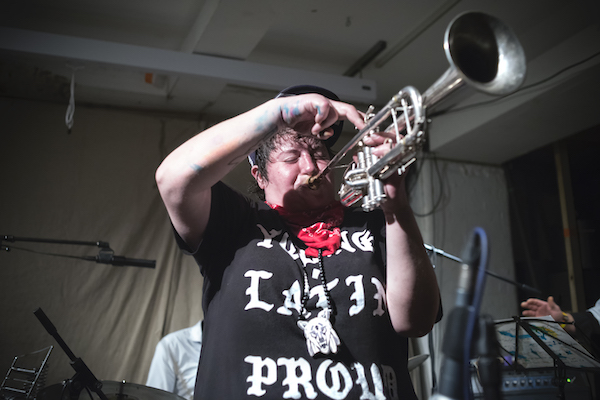Oct 28, 2025 10:47 AM
In Memoriam: Jack DeJohnette, 1942–2025
Jack DeJohnette, a bold and resourceful drummer and NEA Jazz Master who forged a unique vocabulary on the kit over his…

Jaimie Branch’s approach to visual scores developed further while writing music for her latest album, Fly Or Die II.
(Photo: Dawid Laskowski)Jaimie Branch wants to hear music that breathes. The trumpeter-composer out of Chicago, and now based in New York, presents strong musical concepts primed for exploration and peer input.
With each release, Branch taps into unrestrained experimentation, preferring to conjure compositions, rather than write them down and count them off. The practice of letting music reveal itself relates to every facet of her work, from rhythmic ideas to composition.
“Everybody has their own personality when it comes to time,” Branch said. “That’s something I love about jazz. Instead of bars, I think in beats—of everything as in 1. [It’s] like there’s a really fast metapulse. It’s always happening. Within that, you have these gigantic, slow beats.”
Because Branch’s approach to music encourages a multitude of interpretations from bandmates, she draws on myriad techniques for writing charts. “The way your compositions look is going to affect the way your band approaches them,” she said. The first Fly Or Die sessions, which were released through Chicago’s International Anthem in 2017, included what Branch considers traditional notation, graphic notation and illustrations. For her second full-length—Fly Or Die II, due out Oct. 2—she introduced color.
Similar to the way chewing gum while studying and subsequently taking an exam is said to help students recall information, Branch thinks the color-coded charts can help her bandmates recall sections of music. “I wanted to see what happened if the band is seeing yellow,” she said. “When they’re playing, they can kind of remember the next thing that’s coming up as blue.”
On the road, Branch and her ensemble have nurtured a strong musical connection, and in the studio, she values their collective ability to engage in dialogue. “Coming up on the Chicago scene,” she said, “there’s a shared vocabulary and knowledge of jazz. There’s also a whole separate shared vocabulary of Chicago improvised music.”
Beyond vocabulary, her collaborators appreciate the bandleader’s depth of expression. “Jaimie is a visionary,” said Chad Taylor, who played drums on both of Branch’s releases and was a Chicago mainstay for years in a cohort of performers that included multidisciplinary artist Rob Mazurek. “I’m not talking about being pioneering or cutting-edge, but more about her process. She envisions what feelings she wants to evoke with her music and then shapes and writes music to accomplish these goals.”
Fly Or Die II initially came together in London, where her central quartet spent one day in the studio reviewing charts and working out ideas, then two nights playing live. “We played the whole record twice,” said Branch, who also flexes her singing voice on two tracks of the new album. Following the London sessions, the bandleader then enjoyed two additional days in the studio for recording and overdubs.
Something of a purist, Branch tends toward a limited production approach, but spent significant time producing the tracks “twenty-three n me, jupiter redux” and “nuevo roquero estéreo.” Finding the former to be “slightly anemic” compared to others works on the album, she returned to Chicago to add synths, layered trumpets, “alien chatter” and a tambourine. “I wanted to take the tune and put it in a different environment,” she said. “So, [now it’s] a free-jazz band playing in an alien space bar.”
Engaging demons—namely substance abuse—long has shadowed many an artist’s creative process. And Branch has been open about her experience with addiction, despite misgivings of potentially glorifying heroin use. Throughout her recovery, she’s experienced certain revelations. There’s one in particular that she considers worth sharing with others.
“I think there’s a fear when you put down heroin that, ‘Now my music is going to be gone, too,’” she said. “But it became clear that the drugs were actually hindering the creative process. It’s not like, you stop using drugs and all your problems go away. But the music didn’t go anywhere. And I think I was really scared it would.”
With each new project, Branch remains true to her take on music, sound and expression—and her invitation to openness. “I don’t have major concerns about people nailing things,” she said. “That’s just not that interesting to me. I’d rather hear what people can do when they can breathe with it.” DB

Jack DeJohnette boasted a musical resume that was as long as it was fearsome.
Oct 28, 2025 10:47 AM
Jack DeJohnette, a bold and resourceful drummer and NEA Jazz Master who forged a unique vocabulary on the kit over his…

D’Angelo achieved commercial and critical success experimenting with a fusion of jazz, funk, soul, R&B and hip-hop.
Oct 14, 2025 1:47 PM
D’Angelo, a Grammy-winning R&B and neo-soul singer, guitarist and pianist who exerted a profound influence on 21st…

Kandace Springs channeled Shirley Horn’s deliberate phrasing and sublime self-accompaniment during her set at this year’s Pittsburgh International Jazz Festival.
Sep 30, 2025 12:28 PM
Janis Burley, the Pittsburgh International Jazz Festival’s founder and artistic director, did not, as might be…

Jim McNeely’s singular body of work had a profound and lasting influence on many of today’s top jazz composers in the U.S. and in Europe.
Oct 7, 2025 3:40 PM
Pianist Jim McNeely, one of the most distinguished large ensemble jazz composers of his generation, died Sept. 26 at…

Drummond was cherished by generations of mainstream jazz listeners and bandleaders for his authoritative tonal presence, a defining quality of his style most apparent when he played his instrument unamplified.
Nov 4, 2025 11:39 AM
Ray Drummond, a first-call bassist who appeared on hundreds of albums as a sideman for some of the top names in jazz…